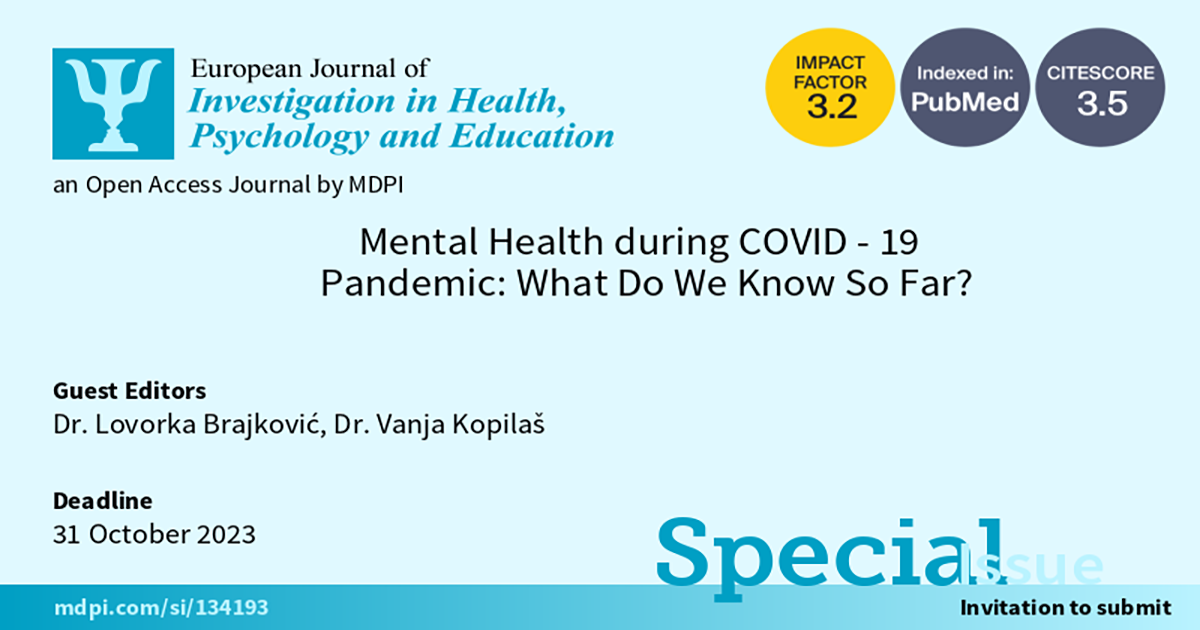Mental Health during COVID-19 Pandemic: What Do We Know So Far?
A special issue of European Journal of Investigation in Health, Psychology and Education (ISSN 2254-9625).
Deadline for manuscript submissions: closed (31 October 2023) | Viewed by 63716

Special Issue Editors
Interests: psychology; public health; clinical psychology; biopsychology; palliative psychology
Special Issues, Collections and Topics in MDPI journals
Interests: clinical psychology and neuroscience; cognitive psychology; biopsychology; neuropsychology
Special Issues, Collections and Topics in MDPI journals
Special Issue Information
Dear Colleagues,
Since its outbreak in December of 2019, the COVID-19 pandemic has changed our lives. Fear of infection combined with various epidemiological measures has affected our everyday functioning. Increased levels of fear, worry, stress and anxiety are expected during situations like these in which our lives are significantly changed and threatened. Due to this sudden change, there is an increased need for psychological services. However, in current times and the modern world we are living in, mental health professionals are faced with a wide spectrum of mental health challenges that are not necessarily related just to the COVID-19 pandemic.
Hence, the adaptation of proper clinical psychodiagnostic and assessment tools is required.
This Special Issue calls for the submission of manuscripts related to the status of mental health in the modern world, and different factors (emotional, social, cognitive and physiological) associated with psychological well-being.
Dr. Lovorka Brajković
Dr. Vanja Kopilaš
Guest Editors
Manuscript Submission Information
Manuscripts should be submitted online at www.mdpi.com by registering and logging in to this website. Once you are registered, click here to go to the submission form. Manuscripts can be submitted until the deadline. All submissions that pass pre-check are peer-reviewed. Accepted papers will be published continuously in the journal (as soon as accepted) and will be listed together on the special issue website. Research articles, review articles as well as short communications are invited. For planned papers, a title and short abstract (about 100 words) can be sent to the Editorial Office for announcement on this website.
Submitted manuscripts should not have been published previously, nor be under consideration for publication elsewhere (except conference proceedings papers). All manuscripts are thoroughly refereed through a single-blind peer-review process. A guide for authors and other relevant information for submission of manuscripts is available on the Instructions for Authors page. European Journal of Investigation in Health, Psychology and Education is an international peer-reviewed open access monthly journal published by MDPI.
Please visit the Instructions for Authors page before submitting a manuscript. The Article Processing Charge (APC) for publication in this open access journal is 1400 CHF (Swiss Francs). Submitted papers should be well formatted and use good English. Authors may use MDPI's English editing service prior to publication or during author revisions.
Keywords
- mental health
- clinical psychology
- depression
- anxiety
- stress
- trauma
- resilience
- quality of life
- modern world
- COVID-19
Benefits of Publishing in a Special Issue
- Ease of navigation: Grouping papers by topic helps scholars navigate broad scope journals more efficiently.
- Greater discoverability: Special Issues support the reach and impact of scientific research. Articles in Special Issues are more discoverable and cited more frequently.
- Expansion of research network: Special Issues facilitate connections among authors, fostering scientific collaborations.
- External promotion: Articles in Special Issues are often promoted through the journal's social media, increasing their visibility.
- e-Book format: Special Issues with more than 10 articles can be published as dedicated e-books, ensuring wide and rapid dissemination.
Further information on MDPI's Special Issue polices can be found here.







